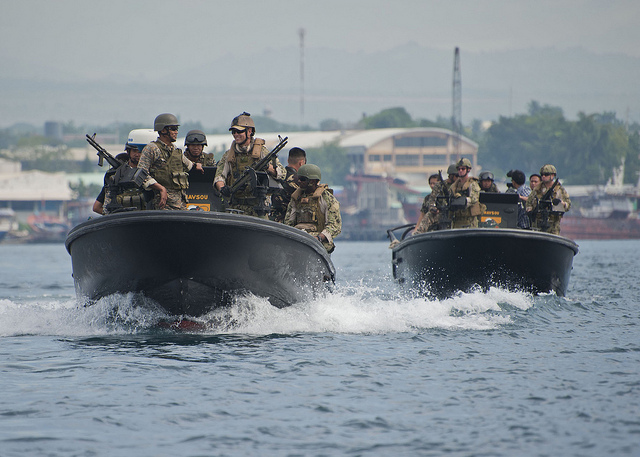The Armed Forces of the Philippines (AFP) is generally considered among the weakest in the region. But as China gradually chips away at the Philippines’ hold on and claims to a whole host of land features as well as fisheries and hydrocarbon resources within its 200-nautical-miles Exclusive Economic Zone (EEZ), there has been a much more concerted effort at ramping up the Southeast Asian country’s defensive capabilities, particularly under the administration of President Benigno Aquino III.
On December 2012, Aquino oversaw the passage of the Revised AFP Modernization Act, amending the 1995 AFP Modernization Act and extending the AFP’s modernization for another 15 years. The aim is to develop the country’s minimum deterrence capability as well as its domain awareness across contested waters within the Philippines’ EEZ. The AFP Modernization Act has served as the primary source of funds for procurements to augment the AFP’s capabilities, while the annual defense budget has largely been dedicated to compensation of personnel and maintenance of existing defense hardware.
In his first three years in office, President Aquino allocated US$648.44 million to modernizing the AFP. The year 2013 saw a 17% increase in defense spending, with Aquino allocating US$1.73 billion for defense procurement in the 2013-2017 period. The significant increase in defense spending and procurement funds came on the heels of a dangerous Philippine-China standoff over the Scarborough Shoal and the Philippines’ subsequent decision to initiate compulsory arbitration vis-à-vis territorial disputes in the South China.
Strategic Blunder
A toxic combination of chronic bureaucratic corruption, underinvestment and misallocation of funds, and an excessive focus on counter-insurgency and internal security operations has contributed to the AFP’s awry state of affairs. The Philippine constitution also obliges the government to ensure education spending always outstrips defense expenditures.
Additionally, the Philippines has an age-old strategic culture of overreliance on American military support — under the aegis of the 1951 Mutual Defense Treaty (MDT), and through the Excess Defense Articles, the Military Assistance, and the Foreign Military Sales programs — against external threats. The termination of American military presence on Philippine soil (1992) as well as the formal cessation of hostilities with the Moro National Liberation Front (1996), the country’s largest insurgency group at the time, however, provided a unique opportunity for the Philippines to modernize the AFP. China’s coercive occupation of the Mischief Reef in 1995 underlined the urgency of the matter.
Through the 1995 AFP Modernization Act, the Ramos administration (1992-1998) sought to transform the AFP into a modern, capable, and self-reliant force against external aggression. But misallocation of funds and bureaucratic corruption undermined the modernization of the AFP. Peace negotiations with leading rebel groups also failed to end decades-old insurgency in the Muslim-majority and under-developed regions of the country. It didn’t take long before the Philippines had to invite the U.S. back to the Philippines, culminating in the 1998 Visiting Forces Agreement.
Ramos’ successors, particularly Joseph Estrada (1998-2001) and Gloria Macapagal-Arroyo (2001-2010), were primarily focused on domestic insurgency. The “Global War on Terror” saw robust bilateral cooperation between the Bush administration and its Filipino counterpart against al-Qaeda-affiliate groups in Southeast Asia. Meanwhile, the Estrada and Arroyo administrations primarily relied on bilateral and multilateral (under the aegis of the ASEAN) diplomacy to manage territorial disputes in the South China Sea. Under the Arroyo administration, there was a significant improvement in Philippine-China relations, culminating in the trilateral 2005 Joint Maritime Seismic Understanding (JMSU) agreement in the South China Sea.
Catch Up Time
Aquino’s rise to power in 2010, however, coincided with rising tensions in the South China Sea, especially as China ramped up its paramilitary patrols, military drills, and construction activities in the area. Accordingly, the Philippines’ defense spending increased from $1.24 billion in 2004 to $2.3 billion in 2009 and $3.47 billion in 2013, a 36 percent increase in less than a decade. By 2015, the Philippines defense spending is expected to grow by as much as 29% , bolstered by around $450 million from the Revise AFP Modernization Act. As a percentage of GDP, however, the Philippines’ defense spending has remained relatively constant, hovering at just around 1%.
Similar to President Ramos, Aquino also vigorously pursued peace negotiations with leading rebel groups to help the AFP to focus on external security. Under his watch, there has also been a more targeted focus on developing the Philippines’ naval and airforce capabilities. Since 2005, when the Philippines permanently retired its fleet of F-5 fighters, the country hasn’t fielded a single (modern) fighter aircraft. So Aquino signed (Feb. 2014) a deal with Korea Aerospace Industries for the delivery of twelve FA 50 lead-in fighter jets, worth $415.7 million, with the first delivery expected by December 2015 and to be completed by 2017.
Meanwhile, the Philippine Navy (PN) has gradually beefed up its antiquated, miniscule fleet. The PN acquired the BRP Gregorio Del Pilar (PF15) and BRP Ramon Alcaraz (PF16), Hamilton– and Hero-class cutters worth up to $400 million, in 2012 and 2013, respectively. Since 2013, the Philippines has been on a shopping spree, acquiring 28 M113 APCs from Israel; 5 Bell-205 helicopters from Germany; 8 helicopters from Poland, and 25 Humvees from the U.S. 8 By 2015, 8 Bell-412 combat utility helicopters and 8 AW109 Power attack helicopters are set to be delivered.
Allies are also pitching in. In 2014, Washington increased its Foreign Military Financing to the Philippines to $40 million, with $14.5 million earmarked for the enhancement of the Philippines’ surveillance and maritime security capabilities. The Philippine Coast Guard (PCG) is also set to benefit from the delivery of the first 3 of 10 multi-role patrol boats from Japan by the third quarter of 2015, while South Korea has donated a Pohang-class corvette to the PN.
The Philippines has experienced arguably its most significant defense buildup under the Aquino administration, but it is far from clear whether the country will develop a minimum deterrence capability anytime soon to push back against China’s relentless assertiveness in the South China Sea.
